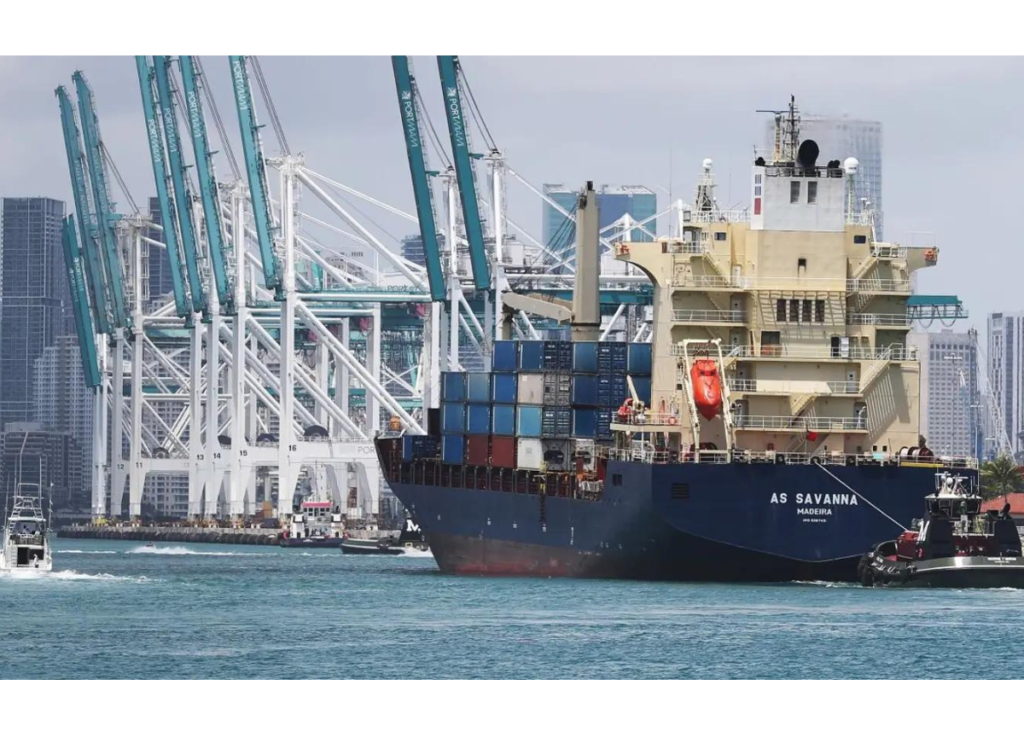
Port employers met with the White House as a potential port strike looms next week. (Joe Raedle/Getty Images / Getty Images)
As the clock ticks toward a potential strike at major East Coast and Gulf Coast seaports, the Biden administration has stepped in, holding urgent discussions with representatives from port employers. A strike could begin as soon as October 1 if no agreement is reached between the U.S. Maritime Alliance (USMX) and the International Longshoremen’s Association (ILA), the union representing nearly 45,000 dockworkers across 36 ports. The White House, while refraining from direct intervention, is actively facilitating negotiations in an attempt to avert a strike that could severely impact U.S. supply chains.
What is at Stake?
If the ILA goes on strike, the consequences would ripple across the economy, affecting industries that rely heavily on the efficient movement of goods. The 36 ports at risk of shutdown handle millions of tons of cargo, including essential commodities such as fuel, food, and retail products. Some of the busiest and most critical ports involved include:
- Port of New York and New Jersey: The largest port on the East Coast, handling 20% of all containerized cargo entering the U.S.
- Port of Savannah: A major hub for imports and exports, especially for agricultural products.
- Port of Houston: A vital Gulf Coast port handling oil, gas, and chemical shipments.
A strike would delay the delivery of these critical goods, disrupting manufacturing, retail, and energy sectors across the country. The economic impact could amount to billions of dollars in losses for businesses that depend on timely shipments.
Key Issues in the Labor Dispute
The labor dispute between the USMX and ILA has been brewing for months, with both sides struggling to reach a consensus on several crucial issues:
- Wages: The dockworkers are pushing for significant wage increases to keep pace with inflation and the rising cost of living. They argue that their work—often dangerous and requiring long hours—demands better compensation, especially given their role in maintaining supply chains during the COVID-19 pandemic.
- Automation: One of the most contentious issues is the growing automation at U.S. ports. While USMX has advocated for the implementation of automated technology to increase efficiency and reduce operational costs, the ILA has resisted. Dockworkers fear that increased automation could lead to widespread job losses, threatening their livelihoods. The union argues that port automation has not demonstrated significant gains in productivity, while it has the potential to displace thousands of workers.
- Work Conditions: The ILA is also negotiating for better safety standards and improved working conditions. The nature of dock work is physically demanding, and union members are calling for stricter regulations around worker safety, especially in handling hazardous materials.
Biden Administration’s Involvement
https://theusfocus.com/u-s-mortgage-rates-fall-to-two-homebuyers-and-sell/Despite the urgency of the situation, President Biden has made it clear that he does not intend to invoke the Taft-Hartley Act, a federal law that would allow the administration to impose a “cooling-off” period to delay the strike. Instead, the White House has adopted a facilitative role, encouraging both sides to return to the bargaining table.
Senior officials from the White House, the Labor Department, and the Department of Transportation have been in communication with both parties. Transportation Secretary Pete Buttigieg and Acting Labor Secretary Julie Su have met with USMX officials to convey the administration’s position: both sides must negotiate in good faith, and quickly, to prevent a work stoppage.
USMX Files Unfair Labor Complaint
In a dramatic escalation of tensions, the U.S. Maritime Alliance (USMX) filed an unfair labor practice complaint against the ILA with the National Labor Relations Board (NLRB) on Thursday. The complaint accused the dockworkers’ union of refusing to participate in negotiations. The USMX stated that it had been trying to meet with the ILA to discuss terms for a new master contract, but the union has repeatedly declined.

The USMX argues that it values the ILA’s contributions and wishes to continue negotiations. However, in their view, the ILA’s refusal to negotiate has left them no choice but to seek injunctive relief to compel the union to return to the bargaining table. USMX is pushing for this relief to avoid the catastrophic consequences a strike would bring to the U.S. economy.
ILA’s Response: A “Publicity Stunt”
The ILA responded strongly, calling the USMX’s labor complaint a “publicity stunt.” According to the union, it is the USMX, not the ILA, that has failed to address key issues such as compensation for dockworkers and working conditions. The ILA pointed out that many local agreements had been settled over the past year due to the union’s persistent negotiations. They further criticized the timing of USMX’s filing—just days before the expiration of the current master contract—suggesting that it was a strategic move designed to paint the union in a negative light.
Why the Strike is Important: Economic Impact and Supply Chain Risks
A potential strike would bring significant disruption to U.S. supply chains, which are still recovering from the effects of the COVID-19 pandemic and the aftermath of the West Coast dockworkers’ strike earlier this year. The timing could not be worse, as businesses prepare for the holiday season, traditionally a peak period for imports and exports.

The ILA’s strike could begin Tuesday if a deal with USMX isn’t reached by midnight Monday. (Luke Sharrett/Bloomberg via Getty Images / Getty Images)
- Retail and Manufacturing: Many companies rely on just-in-time inventory systems, meaning even short delays can cause production slowdowns, stock shortages, and financial losses.
- Energy and Commodities: Gulf Coast ports are crucial for the transport of oil, gas, and other energy commodities. A strike could lead to energy price spikes, which would have knock-on effects across the economy.
- Consumer Goods: Everything from electronics to clothing passes through these ports, and a work stoppage could delay shipments for weeks, driving up prices and limiting availability during the crucial holiday season.
What Happens Next?
With the strike deadline fast approaching, both sides remain entrenched in their positions. If an agreement is not reached by midnight on Monday, dockworkers are prepared to strike starting Tuesday, October 1. This would halt operations at East Coast and Gulf Coast ports, bringing much of the nation’s shipping to a standstill. The impact would be felt by businesses and consumers alike, with delays in goods, rising prices, and potential economic fallout in the billions.
The next few days are critical, as USMX and the ILA navigate their differences under the watchful eye of the Biden administration. Whether a last-minute deal can be reached remains to be seen, but the consequences of failure are clear and potentially disastrous for the U.S. economy.
SEO Keywords: port strike 2023, dockworkers strike, USMX ILA negotiations, East Coast port strike, Gulf Coast port disruption, supply chain crisis, port automation debate, Biden administration labor dispute, Taft-Hartley Act








